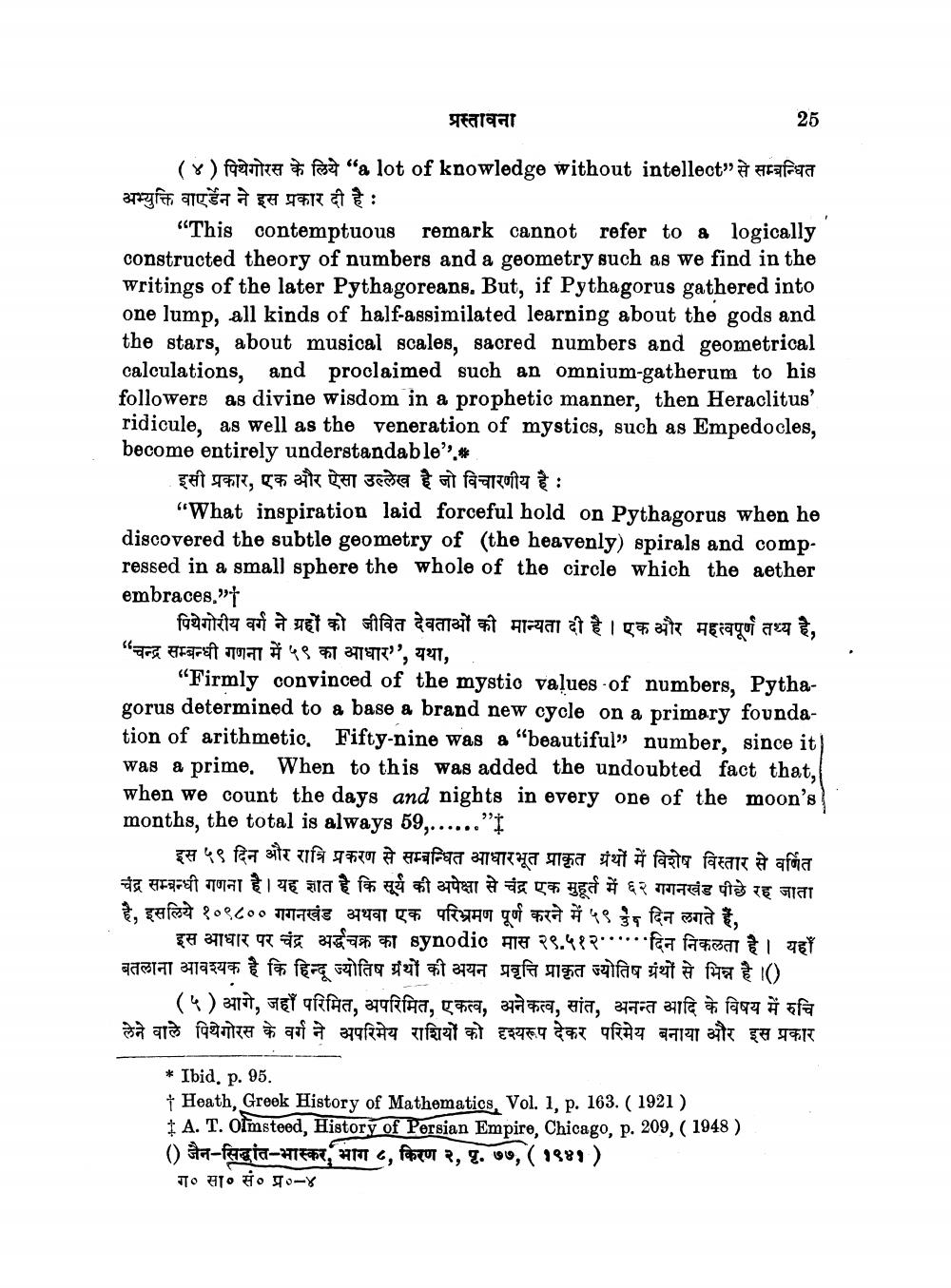________________
प्रस्तावना
25
(४) पिथेगोरस के लिये "a lot of knowledge without intellect" से सम्बन्धित अभ्युक्ति वाएर्डेन ने इस प्रकार दी है:
"This contemptuous remark cannot refer to a logically constructed theory of numbers and a geometry such as we find in the writings of the later Pythagoreans. But, if Pythagorus gathered into one lump, all kinds of half-assimilated learning about the gods and the stars, about musical scales, sacred numbers and geometrical calculations, and proclaimed such an omnium-gatherum to his followers as divine wisdom in a prophetic manner, then Heraclitus' ridicule, as well as the veneration of mystics, such as Empedocles, become entirely understandable''.*
इसी प्रकार, एक और ऐसा उल्लेख है जो विचारणीय है:
"What inspiration laid forceful hold on Pythagorus when he discovered the subtle geometry of (the heavenly) spirals and compressed in a small sphere the whole of the circle which the aether embraces."t
पिथेगोरीय वर्ग ने ग्रहों को जीवित देवताओं की मान्यता दी है । एक और महत्वपूर्ण तथ्य है, "चन्द्र सम्बन्धी गणना में ५९ का आधार', यथा, ..
___"Firmly convinced of the mystic values of numbers, Pythagorus determined to a base a brand new cycle on a primary foundation of arithmetic. Fifty-nine was a “beautiful number, since itj was a prime, When to this was added the undoubted fact that, when we count the days and nights in every one of the moon's months, the total is always 69,......"
इस ५९ दिन और रात्रि प्रकरण से सम्बन्धित आधारभूत प्राकृत ग्रंथों में विशेष विस्तार से वर्णित चंद्र सम्बन्धी गणना है। यह ज्ञात है कि सूर्य की अपेक्षा से चंद्र एक मुहूर्त में ६२ गगनखंड पीछे रह जाता है, इसलिये १०९८०० गगनखंड अथवा एक परिभ्रमण पूर्ण करने में ५९ 3 दिन लगते हैं,
इस आधार पर चंद्र अर्द्धचक्र का synodic मास २९.५१२...."दिन निकलता है। यहाँ बतलाना आवश्यक है कि हिन्द ज्योतिष ग्रंथों की अयन प्रवृत्ति प्राकृत ज्योतिष ग्रंथों से भिन्न है।)
(५) आगे, जहाँ परिमित, अपरिमित, एकत्व, अनेकत्व, सांत, अनन्त आदि के विषय में रुचि लेने वाले पिथेगोरस के वर्ग ने अपरिमेय राशियों को दृश्यरूप देकर परिमेय बनाया और इस प्रकार
* Ibid. p. 95. + Heath, Greek History of Mathematics, Vol. 1, p. 163. ( 1921) + A. T. Olmsteed, History of Persian Empire, Chicago, p. 209, (1948) () जैन-सिद्धांत-भास्कर भाग ८, किरण २, पृ. ७७, (१९४१)
ग० सा० सं० प्र०-४




